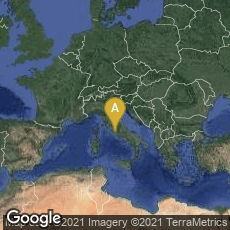

De aquaeductibus, or De aquaeductu urbis Romae, written about 100 CE by the Roman senator Sextus Julius Frontinus, provides a history and description of the water supply of ancient Rome, and the laws governing its use and maintenance. It is the earliest surviving official report of an investigation on Roman engineering, with major implications for Roman public health.
Remarkably, Frontinus's text, which has been extensively read and studied since its discovery in the library of the abbey of Monte Cassino (Montecassino) on July 9, 1429 by humanist/ bookhunter Poggio Bracciolini, is entirely dependent upon the single manuscript that Poggio discovered, and as Poggio wrote to his friend Niccolò de' Niccoli, the manuscript is so full of mistakes, and is so badly written, that it remains very difficult to read. In spite of these difficulties with the text, access to the information that Frontinus provided came at a strategic time just as Renaissance Rome was reviving and began to require a dependable source of pure water. Over the centuries engineers, mathematicians and classicists have grappled with the difficulties in the text.
The manuscript of Frontinus's De aquaeductibus at Monte Cassino was written about 1130 by Peter the Deacon, librarian of Monte Cassino.
"Errors, of course, are normally to be expected in a text that has been copied and recopied over the centuries. But in this manuscript they are unusually frequent, and there are in addition numerous spaces left blank where the copyist seems to have been unable to decipher the exemplar from which he was transcribing. Readers, beginning with Poggio himself, have been faced with rather serious editorial problems--merely to achieve a modest coherence of grammar and sense. Scholarly landmarks in this critical study are the editions of Giovanni Poleni (Padua 1722) and Franz Buecheler (Leipzig 1858). While many difficulties have been removed, a large number still remain either apparently beyond hope or admitting of no straightforward solution. In most cases, happily, we can be reasonably confident of the general meaning" (A "New" Translation of Frontinus De Aquaeductu Urbis Romae by R. H. Rodgers, accessed 06-12-2015).
Frontinus's brief work was first translated into English as The Two Books on the Water Supply of the City of Rome of Sextus Julius Frontinus, Water Commissioner of the City of Rome, A.D. 97. A photographic reproduction of the sole original Latin manuscript and its reprint in Latin; also, a translation into English, and explanatory chapters by Clemens Herschel,Boston, 1899. Herschel's translation was revised by Mary B. McIlwaine, for the Loeb Classical Library edition of 1925, edited by Charles E. Bennett. The Bennett / McIlwaine translation was in turn revised by R. H. Rodgers for the latest and best edition (Cambridge: Univ. Press 2004).
Both the place and publisher of the 1487 editio princeps of Frontinus (sometimes thought to be printed in 1483) are unstated but inferred by bibliographers. The edition is described bibliographically by the ISTC as if00324000. A digital facsimile is available from the Bayerische Staatsbibliothek at this link. That library dates the edition between 1487 and 1490.